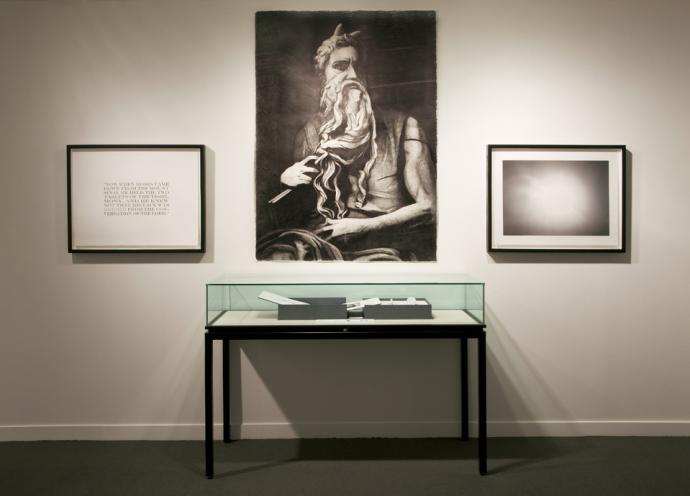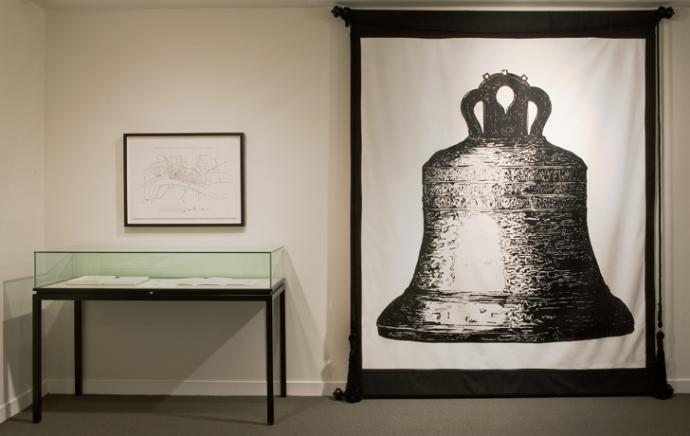from pastelegram.org, June 2011 – April 2014
Andrew Douglas Underwood: Archive of Shadows
Archive of Shadows, Andrew Douglas Underwood’s exhibition at SMU’s Hawn Gallery, lends an aura of mystery to materials of an apparently documentary nature. The exhibition includes five works, each of which is a collection of texts, prints, photographs and other materials displayed within and around a vitrine. Each artwork centers around an object of historical or quasi-historical interest: Hawthorne in Salem (2010-2011) presents the House of Seven Gables, a seventeenth-century house in Salem, Massachusetts that inspired Nathaniel Hawthorne’s novel of that name. I.C.U.S.X. & E.R. (2010-2011) alludes to a possible affair between Queen Elizabeth and Robert Devereux, the second Earl of Essex, before his execution for treason in 1601. The Claude Glass (2011) is an optical device used to imitate the work of the seventeenth-century landscape painter and The Two Lives of Great Tom of Westminster (2011) concerns a large bell moved from the Palace of Westminster to St. Paul’s Cathedral in 1698. The Horns of Moses (2011) revolves around Michelangelo’s sculpture which, based on Saint Jerome’s mistranslation of the Hebrew in Exodus 34:30, has the lawgiver with “horns” (Keren) on his head instead of the radiant or shining face (Karan) that he is said to have had when descending from Mount Sinai.

The power of this kind of work partly depends on its ambiguity—are these things historical, mythical or both? In this case, I think the focus on one particular historic period reinforces the work’s ambiguity. Many of the thematic references here point to the sixteenth and seventeenth centuries, perhaps because this was the period of the scientific revolution, when astronomy diverged from astrology, Newtonian mechanics suggested a clockwork universe and Renaissance humanists such as Lorenzo Valla cast a skeptical gaze on supposedly ancient texts such as the Donation of Constantine. In other words, this was a period in history when facts and myths drew apart from one another, even as they remain entwined. Here, it is not always clear what is fact and what is legend; like a visit to the Museum of Jurassic Technology in Culver City, California, the uncertainty is thrilling.
If the historical ambiguity creates uncertainty, the careful installation presents an air of scholarly authority. As objects, properly speaking, the artworks consist of the prints, photographs and drawings created by the artist. However, their arrangement in and around the Hawn Gallery’s impeccably crafted black-painted vitrines is an inherent part of the work. (Underwood revealed in conversation that if the works were exhibited elsewhere, they might be arranged differently, and would appear in a different set of vitrines.) The physical context of the library also adds to the studious atmosphere, but is not as inherent to the work. The printed texts’ and captions’ font1 is redolent of dusty and venerable library stacks. The materials share an aesthetic of restraint and leave much to viewers’ interpretation.

The closest that a work comes to announcing itself as art is a life-size, eight-by-eleven-foot painting of the famous bell, Old Tom of Westminster, painted in black acrylic on a white ground and mounted on a black banner bearing black finials and black rope tassels. Its black-on-white simplicity is gorgeous, even as one might react with a species of “huh?” (a reaction provoked by a myriad of enigmatic common objects from Ed Ruscha to Karl Haendel).
If you walk around the room from left to right, as people do, the exhibition closes perfectly with an object called Exodus Photograph, part of The Horns of Moses (2011). It is just a white glow on a gray background. Read literally, this is a photograph of the shining face of Moses. Aesthetically, it’s a sublime moment. It is also the moment when the viewerly position of uncritical positivism collapses in on itself; if you had any doubt that this room was an imaginative project, that doubt is now eliminated. No photographs of Moses actually survive, as far as we know, so this must be a simulation by the artist. Having made this deduction, one might appraise the other objects here with a new attitude of skepticism.
- 1. This font is Engravers; a sample can be found at http://www.linotype.com/372/Engravers-family.html.